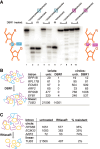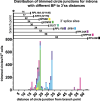Intron lariat spliceosomes convert lariats to true circles: implications for intron transposition
- PMID: 38724209
- PMCID: PMC11146597
- DOI: 10.1101/gad.351764.124
Intron lariat spliceosomes convert lariats to true circles: implications for intron transposition
Abstract
Rare, full-length circular intron RNAs distinct from lariats have been reported in several species, but their biogenesis is not understood. We envisioned and tested a hypothesis for their formation using Saccharomyces cerevisiae, documenting full-length and novel processed circular RNAs from multiple introns. Evidence implicates a previously undescribed catalytic activity of the intron lariat spliceosome (ILS) in which the 3'-OH of the lariat tail (with optional trimming and adenylation by the nuclear 3' processing machinery) attacks the branch, joining the intron 3' end to the 5' splice site in a 3'-5' linked circle. Human U2 and U12 spliceosomes produce analogous full-length and processed circles. Postsplicing catalytic activity of the spliceosome may promote intron transposition during eukaryotic genome evolution.
Keywords: circular RNA; intron transposition; reverse splicing.
© 2024 Ares et al.; Published by Cold Spring Harbor Laboratory Press.
Figures







Update of
-
Intron-lariat spliceosomes convert lariats to true circles: implications for intron transposition.bioRxiv [Preprint]. 2024 Mar 27:2024.03.26.586863. doi: 10.1101/2024.03.26.586863. bioRxiv. 2024. Update in: Genes Dev. 2024 May 21;38(7-8):322-335. doi: 10.1101/gad.351764.124. PMID: 38585890 Free PMC article. Updated. Preprint.
References
-
- Ares M. 2012. Isolation of total RNA from yeast cell cultures. Cold Spring Harb Protoc 2012: 1082–1086. - PubMed
Publication types
MeSH terms
Grants and funding
LinkOut - more resources
Full Text Sources
